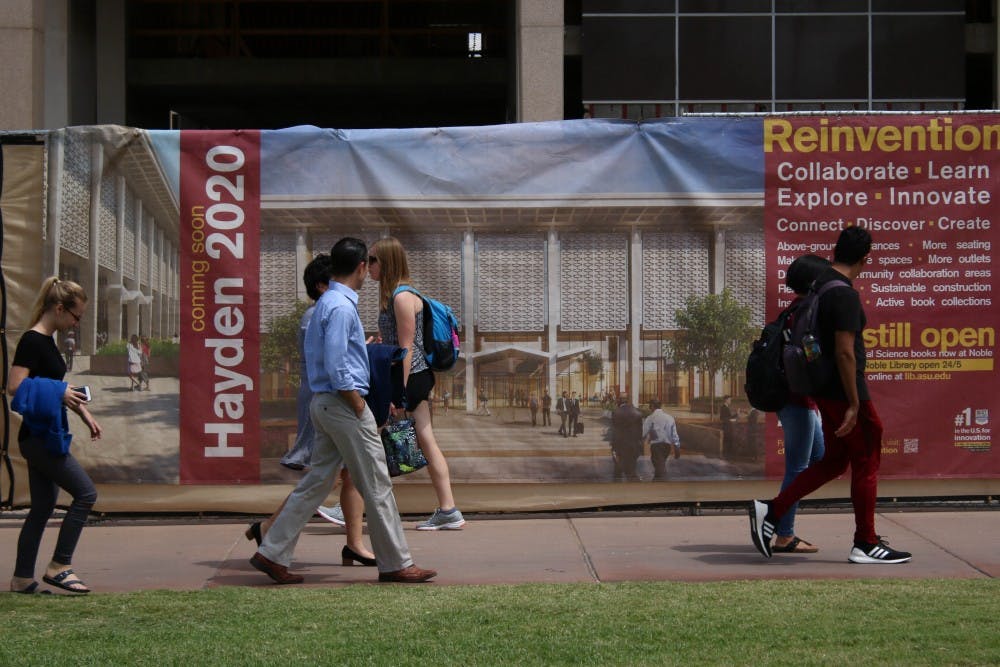In the middle of the Tempe campus, students walk hurriedly past chain link fences that surround the above-ground section of the Hayden Library, headphones drowning out the construction noise. Signs with mock-ups of the project reading "Reinvention" dot the fences.
Hayden’s “Reinvention” is a $90-million endeavor that will take nearly two years. And for ASU, the project represents much more than a needed update to a 50-year-old building: If President Michael Crow wants to build the New American University, he also needs to build a new library.
Establishing ASU as a "leading global center for interdisciplinary research, discovery and development by 2025," and increasing the ASU's social embeddedness are both central to Crow's plans for the New American University. Both these objectives are also embedded into plans for the library renovations.
ASU broke ground on the project last May. Speaking at the ground breaking ceremony, Crow called himself a “library addict” and said the library is “the core of the core of the core” of the University knowledge enterprise.
The library renovations are slated for completion in January 2020.
Among the Hayden improvements are the near doubling of the number of student seats and the addition of multimedia production spaces, gender neutral restrooms, a student kitchen with a microwave, lactation rooms and many more features. The new Hayden will also include a number of entrances on the first floor in order to improve accessibility.
In the renovated library, ASU will move some of its distinctive collections, such as the Chicano/a Research Collection and Labriola National American Indian Data Center, to the first floor. Previously, these collections were kept on the fourth and second floors of Hayden, where they reached fewer people.
The University seeks to create a space to engage the community, said Jennifer Duvernay, the associate University librarian for communications and donor relations.
“We don’t want to be just a book warehouse,” she said. “The library functions almost like a student office.”
But while construction crews hammer away, the up to 10,000 students who walked through Hayden’s doors on busy days before the renovation are left with reduced space within the building.
Chris Maestas, a sophomore studying sustainability, is one of those students. He said the upper floors of Hayden, especially the spaces near windows that looked down on the campus below, were his favorite study spots. And while it was frustrating to come back to campus and realize that he had temporarily lost that space, Maestas said he is hopeful that the new Hayden will be even better.
The underground portion of Hayden has remained open during the renovations, and 150 seats were added to the Noble Science Library, which is now open 24 hours on weekdays. The University has also added seats for up to 400 students in Armstrong Hall, in the east part of campus.
“We’re really trying to mitigate, as much as possible, the negative effect (of the renovation),” Duvernay said. She said that the noisiest construction happens overnight in an attempt to minimize disruption.
The architect for the project is the Maryland-based Ayers Saint Gross, and the contractor is the Atlanta-based Holder Construction Company. The $90 million for the renovation comes from system revenue bonds.
According to Lucie Lapovsky, an economist and higher education finance consultant, most university capital improvement projects are financed through system revenue bonds. This means universities don't pay for the entire project upfront. Instead, they sell bonds to finance the project, which they gradually pay back through student tuition. This means the financial burden for the project is spread across several generations of students during several generations of use.
Modern facilities are critical for universities to recruit new students, a key part of ASU’s strategic business plan, particularly as the University faces what it feels is insufficient funding from the state legislature.
“Today, students look at facilities when they decide what school to go to,” Lapovsky said.
The University wants to make the library accessible for students off-campus as well. Last year, students accessed the library’s online resources from 155 different countries, Duvernay said.
In July 2017, ASU Libraries launched a new library services platform that it hopes will improve the user experience of searching for resources online. Through this platform, the library is working on an application that would allow users to browse online material as if they were looking at a bookshelf — you might search a title, and then you could see what titles might appear next to it, as though you were browsing in a physical library rather than online.
In addition, Duvernay said that ASU Libraries will start piloting a program mid-semester wherein users could pick up books from locations on campus other than the library. They’re also looking to pilot a delivery program to faculty offices.
These delivery programs might help quell complaints from community members about losing easy physical access to books during the renovations. For the renovations, the University moved books from Hayden to the library distribution center on the Polytechnic campus. It also moved some low-circulation books from the Noble Library, making room for 600,000 popular humanities and social science books normally housed in Hayden. Meanwhile, all books can also be requested online.
Logistical inconvenience or not, the concept of the new Hayden Library is the sort of placemaking that's central to Crow's vision for the University — a place where “ideas cross-pollinate."
Reach the reporter at maarmst7@asu.edu or follow @MiaAArmstrong on Twitter.
Like State Press on Facebook and follow @statepress on Twitter.




